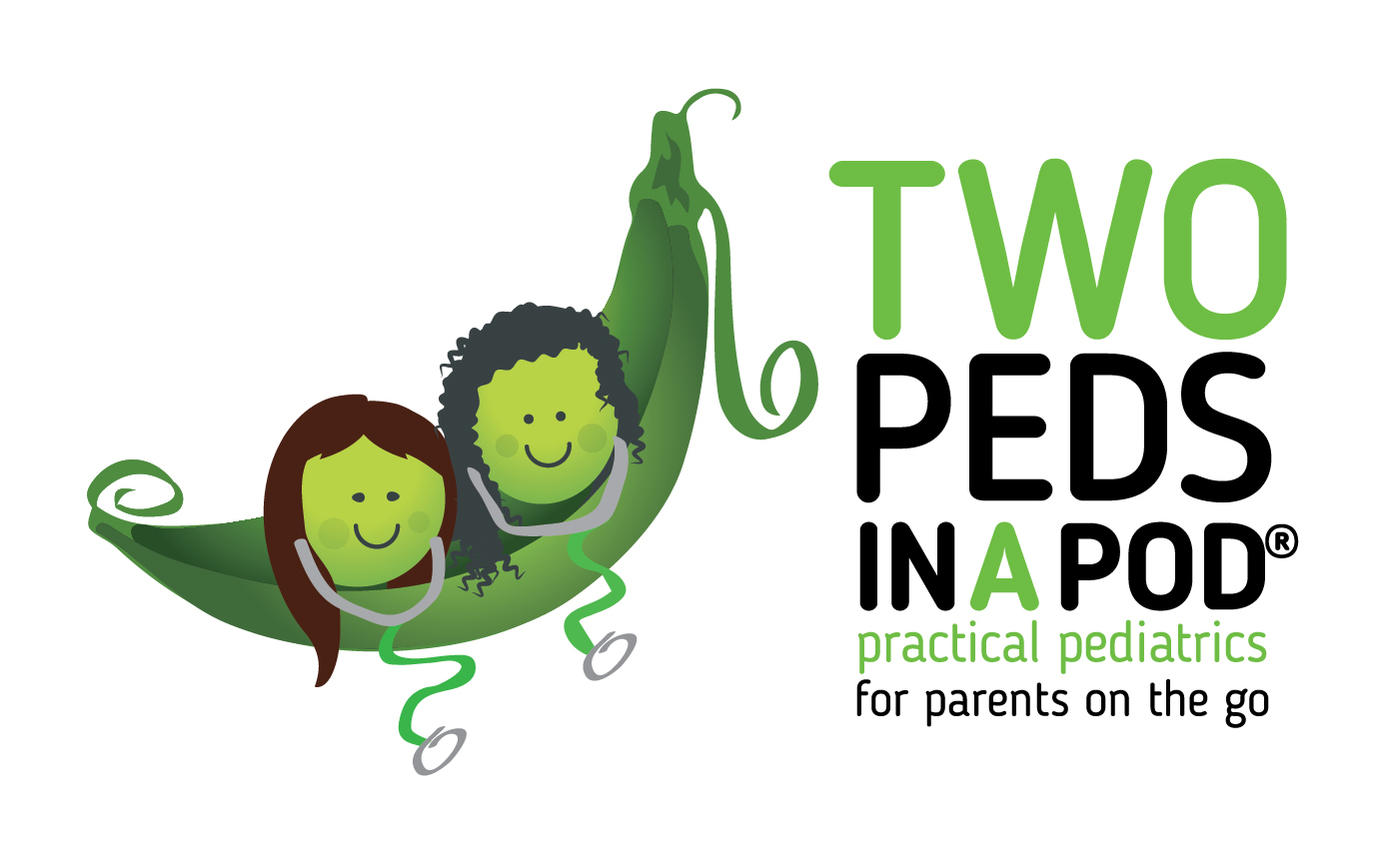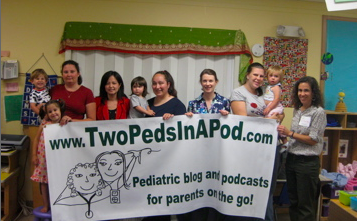 One year ago today we posted our first blog post Maiden Voyage and what an adventure it has been! In honor of Two Peds in a Pod’s first birthday we reprint Dr. Kardos’s post “Let ‘Em Eat Cake”:
One year ago today we posted our first blog post Maiden Voyage and what an adventure it has been! In honor of Two Peds in a Pod’s first birthday we reprint Dr. Kardos’s post “Let ‘Em Eat Cake”:
After completing my pediatric training, I worked for a couple of years in a large pediatric office before I had any children of my own. I was always struck by the Life Event of a child’s first birthday. This milestone carries so much meaning and emotion for families. My patients’ parents described huge birthday parties with characters such as Elmo walking around or Moon Bounces, large catered affairs with numerous friends, family members, and entire neighborhoods. Often I would see a child sick in my office a few days before such an event with parents who were panicked that their child might be sick on his Big Day, or I would see a child for his one year well check and hear many details about the enormous party. Of course I also saw plenty of children a few days after their first birthday party who became ill, most likely, from a well-intentioned friend or relative who was already sick and passed the illness on to the birthday child at the party. I heard about the kids who clapped for the Happy Birthday song and kids who cried and one who vomited from excitement… all over the birthday cake. Many of my patients had their first full blown temper tantrum during their own over-stimulating first birthday party.
I remember not quite understanding why parents go through such effort and expense to throw a party that their child will never remember at a developmental stage where 99 percent of children are having stranger anxiety and separation anxiety. Well meaning famillies would often forgo daily routine to skip naps, eat at erratic times, and then expect their birthday child to perform in front of a large crowd singing loudly at them. “My husband and I will do it differently,” I would tell myself.
Now, three of my own children later, I must apologize for not quite understanding about that first birthday. I remember waking up on the day my oldest turned one year. My pediatrician brain first exclaimed “Hurray! No more SIDS risk!” Then my mommy brain took over, “Ohmygosh, I survived the first year of parenthood!” This day is about Celebration of the Parent. I finally understood completely why my patients’ parents needed all the hoopla.
Because I am actually a little uncomfortable in large crowds, my son’s first birthday party included all close relatives who lived nearby, people he was well familiarized with. Some pediatric tips I had picked up which I will pass on:
1) Sing the Happy Birthday song, complete with clapping at the finale, for about one month straight leading up to the birthday. Children love music and hearing a very familiar song sung by a large group is not as overwhelming as hearing an unfamiliar song.
2) Plan mealtime around your child, not the guests. If you are inviting people close to your heart, they will accommodate. Dinner can be at 5:00pm if that’s when your child usually eats, or have a lunch party that starts midmorning and then end the party in time to allow your child to have his regularly scheduled afternoon nap. Most one-year-olds are usually at their best in the morning anyway.
3) If your child becomes sick, cancel the party. Your child will not be disappointed because he won’t understand what he is missing. You as parent would have a lousy time anyway because all of your attention will be on your ill child and you will be anxious. Your guests who are parents will appreciate your refraining from making them and their own children sick.
Recently while performing a one-year-old well check I asked about my patient’s birthday party and her parents told me “Oh, we didn’t have a party. It was like any other day, although we did give her a cupcake for dessert.”
Now THIS is a pragmatic approach to parenting because, again, no child will ever have memories of her own first birthday. However, I hope the parents did take time, at least with each other, to congratulate themselves and to feel really good about making it to that huge milestone in their parenting career. I hope they savored their accomplishment as much as their child savored the cupcake.
_____________________________
How far we’ve come, and it is all thanks to you. We’ve watched with excitement as our readership climbed from two hits (from our husbands) to almost 20,000 hits. Two Peds in a Pod now has email and Facebook subscribers. You can find us through directories such as Technorati and iTunes and recently, Two Peds expanded to the West Coast of the United States with a bimonthly column in Family Magazine Group. Some of our Face book friends hail from Canada and we consistently receive hits from the United Kingdom. Looks like our goal to impact one million kids around the world may not be a far-fetched dream.
Our greatest reward is when people say to us, “That blog post was so helpful.” We are thrilled to reach out to many families.
While our main podcast recording studio continues to be our kitchen table, we also recorded with one mom’s group in their living room and another parenting group in a child care center. From focus group back out to cyperspace!
We still depend on you to tell other families about our site. Our sources of inspiration continue to be our patients, your children and our own clans. Please keep those topic suggestions coming! As working pediatricians and parents like you, we want to continue to be your reliable (and sometimes amusing) source of sound pediatric information.
Thank you for reading, listening, commenting and letting your friends know about Two Peds in a Pod. Let the adventure continue!
Sincerely,
Julie Kardos, MD and Naline Lai, MD
©2010 Two Peds in a Pod℠
 It happens to almost every adolescent. At some point or another, we all experienced our first love. In the early stages, it was the greatest feeling we had ever felt. When it ended, it was the largest and most powerful feeling of hurt that we had ever experienced. Each moment felt like 10 years. Days went by and life went on for everyone else. Yet, for us, life stopped and we felt lost and paralyzed.
It happens to almost every adolescent. At some point or another, we all experienced our first love. In the early stages, it was the greatest feeling we had ever felt. When it ended, it was the largest and most powerful feeling of hurt that we had ever experienced. Each moment felt like 10 years. Days went by and life went on for everyone else. Yet, for us, life stopped and we felt lost and paralyzed.



 Believe it or not, there are only a few weeks left before school starts for the fall. As I look at last year’s first day of school photo, I notice my not-quite-100-pound child bending in half under the weight of a backpack, trombone, lunchbox and art portfolio. This year, I quietly decree, that scenario will not happen again. To make sure it does not happen at your house either, consider a few tidbits as you plan your back-to-school purchases:
Believe it or not, there are only a few weeks left before school starts for the fall. As I look at last year’s first day of school photo, I notice my not-quite-100-pound child bending in half under the weight of a backpack, trombone, lunchbox and art portfolio. This year, I quietly decree, that scenario will not happen again. To make sure it does not happen at your house either, consider a few tidbits as you plan your back-to-school purchases: In the wake of liquid Tylenol and Motrin recalls, some parents are facing empty shelves of liquid medications in the stores. Check to see if your child weighs enough to take the dose in pill form. If so, it’s time to learn to swallow pills! Here are some of our favorite helpful ideas:
In the wake of liquid Tylenol and Motrin recalls, some parents are facing empty shelves of liquid medications in the stores. Check to see if your child weighs enough to take the dose in pill form. If so, it’s time to learn to swallow pills! Here are some of our favorite helpful ideas: A mom once told me about a time when she left their toddler in the care of her husband who worked from home.
A mom once told me about a time when she left their toddler in the care of her husband who worked from home.  Debunking myths about soy, our guest blogger today is esteemed pediatrician Dr. Roy Benaroch.
Debunking myths about soy, our guest blogger today is esteemed pediatrician Dr. Roy Benaroch. Why does that big pimple always appear the night before prom, picture day, her sweet sixteenth birthday party or any other important event in your teen’s life?
Why does that big pimple always appear the night before prom, picture day, her sweet sixteenth birthday party or any other important event in your teen’s life? We welcome guest blogger Dr. Alissa Packer who informs us about Cryptosporidium.
We welcome guest blogger Dr. Alissa Packer who informs us about Cryptosporidium. 
 One year ago today we posted our first blog post
One year ago today we posted our first blog post  Two Peds in a Pod has made its way from Pennsylvania to California. Check out
Two Peds in a Pod has made its way from Pennsylvania to California. Check out